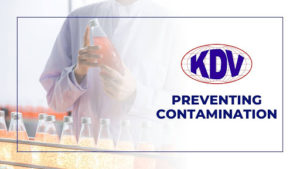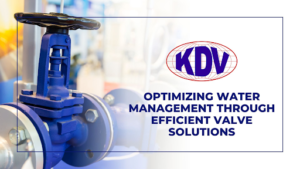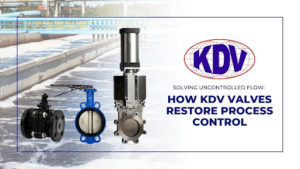Preventing Contamination with KDV Valves
Contamination and cross-contamination are constant threats in industries ranging from food and beverage production to sensitive pharmaceutical manufacturing. None of us want to be associated with contaminated food or medicines—these pose serious risks and potential disasters for human health. Compromised products can lead to costly recalls, jeopardise safety, and severely damage a company’s reputation. That’s why maintaining rigorous control over every aspect of the production process isn’t just important—it’s essential. KDV Valves are precision-engineered with advanced sealing technology and high-quality materials, ensuring your processes remain secure and that contamination risks are minimised for maximum product integrity.
The Nature and Consequences of Contamination
Contamination occurs when any undesirable substance or material enters a product or controlled environment. These contaminants can pose health hazards, degrade product quality, and cause compliance issues. potentially leading to regulatory violations and financial losses for manufacturers.
Understanding Different Types of Contamination:
Biological Contamination: Microorganisms like bacteria, viruses, fungi, and their toxins can infiltrate products, posing significant risks to food safety and pharmaceutical sterility. Even minimal microbial presence can lead to spoilage, reduced shelf life, and compromised product efficacy. These biological contaminants are direct threats to consumer health.
Chemical Contamination: Unwanted chemicals such as pesticides, cleaning agents, heavy metals, or residues from manufacturing can affect product safety and functionality. Strict monitoring and adherence to safety guidelines are necessary to prevent such contamination from affecting consumer well-being even trace amounts of these substances can cause significant health concerns and lead to hefty regulatory penalties.
Physical Contamination: Foreign objects like glass, metal shards, plastic fragments, insects, or dirt can inadvertently enter products. These physical contaminants can damage machinery, present choking hazards, and adversely impact consumer trust, often resulting in costly product recalls. Implementing thorough quality control checks, including metal detection and X-ray inspection systems, can help mitigate these risks.
Cross-Contamination: This occurs when contaminants—whether biological, chemical, or physical—are transferred from one substance, surface, or product to another. Cross-contamination is especially dangerous when dealing with allergens, potent pharmaceuticals, or hazardous materials, as it can lead to widespread contamination and significant health risks. Implementing effective segregation practices, stringent cleaning protocols, and automated monitoring systems can minimise these risks.
Industries Where Contamination Control is Paramount
Food and Beverage Sector: Maintaining stringent hygiene standards is essential to prevent microbial contamination and foodborne illnesses. Additionally, food-grade manufacturing facilities must guard against chemical or physical adulteration. Compliance with HACCP (Hazard Analysis and Critical Control Points) guidelines is key to ensuring food safety.
Pharmaceutical Industry: Ensuring the sterility, purity, and potency of products is fundamental. Contamination can compromise the efficacy and stability of medicines, posing severe risks to patient safety. Adhering to Good Manufacturing Practices (GMP) and using sterile processing equipment are crucial for maintaining high pharmaceutical standards.
Other Critical Sectors:
- Chemical Manufacturing: Preventing unintended cross-contamination or the introduction of impurities is vital. Proper handling and storage of raw materials help minimise contamination risks.
- Water Treatment: Removing biological, chemical, and physical contaminants is essential to ensure safe drinking water. Advanced filtration systems and disinfection techniques, such as UV treatment, play a significant role in contamination prevention.
- Semiconductor Production: Contamination-free environments in cleanrooms are crucial for maintaining the integrity of semiconductor manufacturing. Even microscopic particles can disrupt the production process, making strict air filtration and contamination control measures necessary.
The Role of Valves in Contamination Prevention
Unfortunately, valves that are poorly engineered or not properly maintained can become sources of contamination themselves:
- Leaking Issues: Worn seals, damaged components, or loose connections can cause leaks, allowing fluids or external contaminants to enter your system. Regular maintenance and timely replacement of worn-out seals can prevent leaks and maintain process integrity.
- Cross-Contamination: Valves that don’t fully isolate flows can allow tiny amounts of one fluid to mix with another, leading to cross-contamination. Choosing precision-engineered valves with absolute shutoff capabilities is crucial to prevent unintended mixing.
- Material Incompatibility: If a valve’s materials react with the fluids they’re supposed to control, the valve itself can become a contamination source. Consulting material compatibility charts and selecting corrosion-resistant options help mitigate this issue.
Diaphragm Valves: A Reliable Solution for Contamination Prevention
Given the serious consequences that even minor contamination can cause, choosing the right valve is crucial. Diaphragm valves offer distinct advantages, making them an ideal solution for contamination control. These valves are particularly valued for their ability to achieve excellent fluid isolation, effectively preventing cross-contamination and ensuring the integrity of your processes, particularly in critical applications like pharmaceuticals, food and beverage, and biotechnology. Our design minimises dead space, reducing the risk of microbial growth and facilitating easy cleaning and sterilisation.
Why KDV Valves are the Optimal Choice for Contamination Control
KDV Valves are specifically engineered to address contamination risks while maintaining the highest purity standards across a range of applications.
- What are diaphragm valves used primarily for? Diaphragm valves are extensively used in industries where maintaining hygiene and preventing contamination are paramount, such as food, beverage, and pharmaceuticals. Their ability to provide complete shutoff and prevent product stagnation makes them particularly suitable for sterile processing environments.
- Superior Materials: KDV utilises high-quality materials like stainless steel, PTFE, and PEEK, known for their corrosion resistance and compatibility with a wide variety of chemicals and fluids.
- Custom Material Options: With options including stainless steel and other high-performance materials, KDV valves can be tailored to your specific application, ensuring that the materials won’t react adversely with the substances they contact.
- Precision Engineering: KDV’s valves feature leak-proof seals and precise closures, ensuring that no fluids escape the valve when it’s not in use, thus preserving the purity of your process and preventing contamination.
- Hygienic Design: KDV offers valves with smooth internal surfaces and minimal crevices, making them ideal for applications that require stringent hygiene standards. These features help reduce the risk of microbial growth and facilitate easy cleaning.
Selecting the Right KDV Valve for Your Application
To achieve the best contamination control with KDV valves, careful selection is essential:
- Material Compatibility: Consult compatibility charts or collaborate directly with KDV to ensure the valve’s materials are suitable for the specific substances in your process.
- Appropriate Valve Type: Choose the most suitable valve type for your needs. While diaphragm valves excel in contamination prevention, other types like ball valves and butterfly valves may offer different benefits.
- Pressure and Temperature Ratings: Ensure the valve can handle your regular operating conditions and any potential surges.
- Size and Connection Considerations: The valve must integrate seamlessly into your existing piping system.
Frequently Asked Questions (FAQs) About Preventing Contamination with KDV Valves
1. How do KDV diaphragm valves prevent microbial contamination in sterile environments?
KDV diaphragm valves are designed with a smooth, crevice-free internal structure that minimises bacterial growth and product stagnation. They support clean-in-place (CIP) and sterilise-in-place (SIP) systems, ensuring that all internal surfaces are thoroughly sanitised without dismantling. Additionally, the use of FDA- and USP Class VI-compliant materials enhances their suitability for sterile environments like pharmaceutical and food processing facilities.
2. What makes KDV Valves resistant to cross-contamination in multi-product processing lines?
KDV Valves feature high-purity diaphragms and precision-engineered seals that ensure complete flow isolation. Their unique shutoff mechanism prevents residual fluids from transferring between batches, reducing the risk of cross-contamination. This is particularly crucial in industries such as biotech, pharmaceuticals, and chemical manufacturing, where even trace contamination can compromise product integrity.
3. Can KDV Valves withstand aggressive chemicals and high-temperature sterilisation processes?
Yes, KDV Valves are manufactured using high-performance materials such as PTFE, PEEK, and stainless steel (316L), which offer excellent resistance to corrosive chemicals, extreme pH conditions, and high-temperature sterilisation. These materials ensure long-term durability and consistent performance, even under harsh process conditions commonly found in water treatment, chemical production, and cleanroom applications.
4. How does valve automation improve contamination control in critical processes?
Integrating KDV valves with automated control systems enhances contamination prevention by ensuring precise, repeatable, and human-error-free valve operation. Smart valve actuation can be used to control opening/closing sequences, monitor pressure and flow conditions, and even provide real-time feedback on seal integrity and leakage detection.
5. What maintenance practices should be followed to ensure KDV Valves maintain contamination-free performance?
Routine inspection of diaphragms, seals, and actuator components is essential to prevent potential contamination sources like microbial buildup, seal degradation, and leakage. Using manufacturer-recommended cleaning agents and following a preventive maintenance schedule ensures valves remain in optimal condition.
Securing Your Process with KDV Valves
Preventing contamination is essential for protecting product quality, ensuring safety, and maintaining your brand’s reputation. KDV Valves, with their focus on precision engineering and premium materials, provide a reliable solution for keeping your processes contamination-free. Explore their range of valves to find the ideal solution tailored to your industry and application. Investing in high-quality valves enhances operational efficiency and regulatory compliance, giving you peace of mind in contamination-sensitive industries. Explore their range of valves to find the ideal solution tailored to your industry and application.


